#Lord Rama Sister
Text
RaghavaJanaki - The Reunion
A Sri Ramachandra and Sri Janaki milan in Modern AU only for @harinishivaa
--------------------------------------------------------------------------
"Lakshya, where are you taking me?" Raghav sighed heavily as his over excited younger brother Lakshya pulled him through the narrow lanes of Varanasi.
"Dada!!" chirped the younger brother happily. "You should come with me! I have stumbled upon this beautiful small Palace! It is also beside Ganga River." He told him.
"Okay, that is fine I get it but why pulling me? You could have taken Bhaskar or Shashaank." Raghava said, sighed as his younger brother pulled him more in response. Soon they reached and Raghava couldn't help but gape at the majestic river in front of him.
Paapanashini Ganga flowed majestically, the kal-kal sound of the water so soothing for Raghava that he closed his eyes and inhaled. The heavy flow of River Ganga was a bit faster than that of Sarayu, but still, for him both the Rivers were same. Be it Ganga of North or Kaveri of South, every river was same as Ganga for him.,
"Isn't it beautiful Dada!?" Lakshya asked happily chirping and skipping around, deciding to bring Bhaskar and Shashaank, his another elder brother and Twin soon.
The soft gasp didn't escaped the ears of Raghav as he turned swiftly, his eyes clashing with the doe like black eyes of the golden hied beauty that was holding a little a little basket of flowers.
Ram ko dekh kar, Sri Janaka Nandini,
Baag me vo, Khadi ki Khadi reh gayi..!
(Upon seeing Rama, Sri Janaki stilled in the Garden)
He did not even saw her face properly. He just saw her pink lips parting away in surprise, that oxidised nose-pin glinting under the setting sun, her doe eyes widening and the gentle breeze making her curly hairs dance across her face.
Ram dekhe Siya, aur Siya Ram ko,
Chaaron akhiyan ladi ki ladi reh gayi..!
(Ram looked at Siya and Siya looked at Ram,
Their four eyes clashed together..!)
Sriya wondered if her Bholenath had any hand or any hidden motive in sending her to Flower Garden, for she never realised that she will find a beautiful man with dark skin, shining majestically at due to the setting sun. His lotus petal like brown eyes were the first thing that captured her eyes, and she couldn't help but gasp, which he probably heard.
The Janakpur gaye dekhne ke liye,
Saari Sakhiyaan Jharokhan se Jhaakan lagi..!
Dekhte hi nazar mil gayi dono ki,
Jo jahaa thi khadi ki khadi reh gayi..!
(The went Janakpur to see around, and all the Friend/Sisters {of Siya} started looking through windows. As soon as they saw each other their eyes clashed, and they stilled altogether.)
Raghav didn't really had any motive to come to Varanasi, but Lakshya was bored, so his younger brother tagged him, Bhaskar and Sashank along. On the other hand, Urmi, Mansi and Shikha, Sriya's sisters were decorating the room.
"Hey! Who is that handsome male?" cried Urmi noticing Raghav, and Mansi and Shikha crowded around her near window. Although, this didn't bothered the two individuals, who had stilled in their places as soon as their eyes clashed.
Boli hai ik Sakhi Ram ko dekh kar,
Rach gayi hai vidhata ne jodi sukhad..!
Fir Dhanush kaise todenge vaare Kunwar?
Mann mein Shanka, bani ki bani reh gayi..!
(Upon seeing Ram one of the Sakhi's (Friend) says that the Lord has created a beautiful bond. But how will this gentle looking Prince break the bow? This doubts stayed in their hearts)
"Mahadeva!! They look so good together!!" Urmi wondered with a excited smile. "Of course! Just look at them!" Mansi took their nazar (evil eye) off as she and her sisters gazed at Raghav and Sriya. "Hey but wait- We all know that Jiji is very divine, isn't she? All the Priests and Sages we have met till now said that she is a divine woman, and no ordinary man can be her husband, what if this handsome hunk isn't the one?" Shikha asked, making them humm altogether and cup her cheeks in tension. Will their sister remain unmarried?
Boli dooji Sakhi Chhotan Dekhan mein hai,
Par chamatkaar inka nahin jaanti..!
Ek hi baan mein taadika raakshasi,
Uth saki na, padi ki padi reh gayi..!
(The other Sakhi says that he looks like is short, but she doesn't know the miracle of him. Just with one arrow, the Demoness Taadika didn't got up {after being stuck by})
"Also, he kinda looks short." Shikha's words made Mansi whack her lightly on head, and Urmi giggled. While her sisters were talking and giggling among themselves, Sriya realised something.
Her eyes widened and balance seem to falter, tears brimming in her eyes. It seemed as if a sudden burst of light appeared behind him, the silhouette of a man with a bow in his arms growing large and large, as Sriya almost fainted, but held her ground somehow.
Unknown to her, this handsome dark skinned stranger had same effect. He was divine, his birth on Karthika Purnima or Deva Dipawali and his extraordinary horoscope was not only the indication, but also that his mother was having a hard time finding a woman for him. But when he saw this beautiful damsel looking like the Goddess Ganga with the setting sun reflecting her golden face, he knew she was the one for him, and the silhouette of the regal woman behind her spoke levels.
Ram ko dekh kar, Sri Janaka Nandini,
Baag me vo, Khadi ki Khadi reh gayi..!
48 notes
·
View notes
Photo
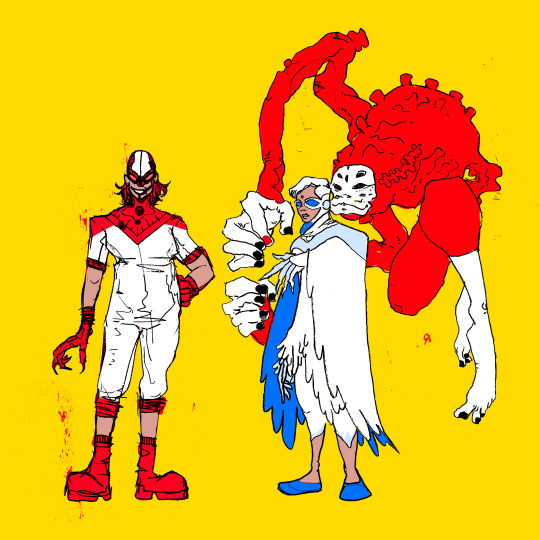
Hawk, Dove, and the Deadman
Empowered by Lords of Chaos and Order Extant and Monarch (themselves former Hawk and Dove Hank and Donald Hill), Holly and Dawn Granger carry on the age-old struggle for balance between the various avatars of mystic universal forces.
Along for the ride is deceased trapeze artist Boston Brand, the Deadman and Avatar of Rama Kushna (the mythic sister-wife of Rama Khan, basis for the hereditary title of the monarch of Jarhanpur). Boston’s role in the struggle of Chaos and Order is unclear, but the effect of the White Lantern Energy on his body and mind speak to a deeper, unifying aspect to the various sources of superhuman power in the multiverse, as if connected to a single Source...
55 notes
·
View notes
Text
Hello everyone following this blog!
Sorry for not updating you all sooner, there were things in my personal life that are keeping me from fully starting the tournament right now (including some preparation I still need to finish) and I feel terrible for not letting you all know the situation of this tournament.
However, as compensation for making you wait, I will now announce our competition during this tournament!
Meet the 32 couples that I chose from your submissions:
1. Gilgamesh x Enkidu (Fate)
2. Nero Claudius x Hakuno Kishinami (Fate/Extra)
3. Shiki Ryougi x Mikiya Kokutou (Kara no Kyoukai)
4. Medea x Souichirou Kuzuki (Fate/Stay Night)
5. Kirei Kotomine x Claudia Hortensia (Fate/Stay Night)
6. Akiha Tohno x Kohaku (Tsukihime)
7. Sakamoto Ryouma x Oryou (Fate)
8. Arthur Pendragon x Ayaka Sajyou (Fate/Prototype)
9. Tamamo-no-Mae x Hakuno Kishinami (Fate/Extra)
10. Yu Mei-ren x Xiang Yu (Fate)
11. Leonardo da Vinci x Romani Archaman (Fate/Grand Order)
12. Sion Eltnam Atlasia x Riesbyfe Stridberg (Melty Blood)
13. Hakuno Kishinami x BB (Fate/Extra CCC)
14. Ozymandias x Neferati (Fate)
15. Saber x Miyamoto Iori (Fate/Samurai Remnant)
16. Rama x Sita (Fate)
17. Artemis x Orion (Fate)
18. Brynhildr x Sigurd (Fate)
19. Ritsuka Fujimaru x Mash Kyrielight (Fate/Grand Order)
20. Iskander x Waver Velvet/Lord El-Melloi II (Fate/Zero and Case Files)
21. Rin Tohsaka x Artoria Pendragon (Fate/Stay Night)
22. Kirei Kotomine x Gilgamesh (Fate/Stay Night)
23. Shinji Matou x Shirou Emiya (Fate/Stay Night)
24. Sieg x Astolfo (Fate/Apocrypha)
25. Gilgamesh x Hakuno Kishinami (Fate/Extra CCC)
26. Shirou Emiya x Sakura Matou (Fate/Stay Night)
27. Ayaka Sajyou x Richard the Lionheart (Fate/Strange Fake)
28. Kadoc Zemlupus x Anastasia Nikolaevna Romanova (Fate/Grand Order)
29. Solomon x Queen of Sheba (Fate)
30. Canaan x Maria Oosawa (Canaan)
31. Mash Kyrielight x Morgan (Fate/Grand Order)
32. Ritsuka Fujimaru x Jeanne d’Arc Alter (Fate/Grand Order)
I’m sorry if your pick didn’t make it in, I unfortunately couldn’t choose all of them with the amount there were and some pairs had to be cut for reasons.
I can’t say when the tournament will be ready to start, but I’ll give a heads-up the day before.
Finally, I leave you all with the current tournament layout right now (any complaints about the background color will be directed at my sister who helped set this up):

That’s all for now. Currently the plan is to start this sometime soon, but I’ll let you know if this changes. Just keep your eyes out for any updates!
#a couple’s battle#tournament preparation#couple tournament#fate apocrypha#fate extra#fate grand order#fate go#fate prototype#fate samurai remnant#fate stay night#fate strange fake#tsukihime#kara no kyoukai#fate/zero#case files#melty blood#fate series#type moon#nasuverse#canaan#the tournament is almost here just hold on for a bit longer
11 notes
·
View notes
Note
Howsabout 😈 and 💀 for all of them >:3. Would love getting some sent back but no pressure!
aaaaa okay !!!!!!! :D
brief descriptor for my ocs that I’ve never mentioned before
Penelope “Penny” Collins, 15, she/they, a troubled and inquisitive high school freshman who definitely isn’t in a child fighting ring at the roller rink (she totally is, her stage name is lens flare). Her mother died and her father left, leaving her under the care of her maternal uncle, Fletcher.
Fletcher “Fletch” Collins, 34, he/xe, a CCRP employee in HR who is explicitly told to ignore every complaint even remotely concerned with the supernatural. He lives with his mom, Mickey, after a messy breakup with his former boyfriend. He has no clue how to take care of a teenager.
Maeve “Mickey” Collins, 67, she/her, a kind old lady who lives near the Witchwood and has seen it all. She’s more of a guardian to Penny than Fletch is. The Collins family is like, super cursed by the way.
😈 - Which Lord in Black would be most likely to target your HF oc?
Penny - Blinky. Penny has the Gift, and is besties with Blinky, à la Hannah and Webby. As Blinky is her bestie, he often influences her more rash decisions and is the first to suggest her to be more of a troublemaker. She was better about ignoring his worse ideas before her mom died.
Fletcher - Wiggly. Fletcher is someone who struggles a lot with his rage, and Wiggly would eat that shit up. He absolutely would have been part of the Wiggly cult if he hadn't been helping his mom make gingerbread cookies on Black Friday. Plus, he wanted to avoid the long lines.
Mickey - Nibbly. Mickey's sister was a Honey Queen, and although Mickey doesn't know exactly what happened to her, she knew that her sister would never completely cut contact with her. Also, she's had a lot of sacrifice in her life, so Nibbly would feed into her feelings of helplessness. Thankfully, she's wise enough now to avoid giving in.
💀 - How privy is your HF oc to the darker goings-on around town, like the shady work of CCRP or the Church of the Starry Children?
Penny - COMPLETELY clueless. She's too full of teenage problems and Roller-Rama stuff learn about the town's history. She does want to know why Hatchetfield is the only place where she's seen others with the Gift, though, as well as learning about the Gift in general.
Fletcher - He's not knowledgeable about it per se, but being part of CCRP gets him closer to the secrets of the town than most. I'm still kind of working on him, but I think he's at least being considered by CCRP as a lab rat because he's very malleable and a good secret keeper.
Mickey - She's seen a lot over the years, so she knows bits and pieces of the town's history, but has more of a "not my problem" attitude about it. As long as her family and friends are safe, she wouldn't care if there's some hooligan cultists in the woods or what have you.
#thank you sooooo much ash!!!!!!!#agghhh it took forever to write. i was away from my phone :(#hatchetfield#ocs#tgwdlm#black friday#starkid#nightmare time#and i sent some earlier!#my hf lore is rusty so i might not remember a few things haha#kirbmail
4 notes
·
View notes
Video
youtube
Ramayan Rahasya | Why Ram gave death penalty to Laxman | Who was Ram's s...
Lord Rama,Sita,Ravan,Hanuman,Lakshman,Ramanand Sagar,Indian mythology,Hindu epic,Doordarshan,Television series,Indian culture,Hindu religion,Ramayan Re-telecast,TRP records,Dara Singh,Sunil Lahiri,Arun Govil,Ramayana,Valmiki Ramayana,Indian epic poetry,Hinduism,Ravindra Jain,Mythological series,Indian epic story,Hindu epic literature,Hindu tradition,Ramkatha,Ramayan Rahasya,Who killed Krishna,Why Ram killed Bali?,Sister of Ram,How did Ram died
2 notes
·
View notes
Text
The Sampurna Ramayan With Each and Every Chapter
"Dharma (righteouness) is more important than any divine boon" https://sanatandharmvoice.blogspot.com/
The Ramayana, one of the two great Indian epics, is an intricate and profound narrative attributed to the sage Valmiki. It's a story of love, duty, honor, and sacrifice, centering around the life of Lord Rama, an incarnation of the Hindu god Vishnu. The epic consists of seven Kandas (books), each revealing different aspects of Rama's life and journey.
1. Balakanda (Book of Childhood):
The story begins with the birth of Rama to King Dasharatha of Ayodhya and Queen Kausalya. As Rama grows up, he demonstrates exceptional valor and righteousness, winning the hearts of his people. He marries Sita, the daughter of King Janaka, by lifting Lord Shiva's divine bow at the swayamvara (a ceremony where a princess chooses her husband). However, Dasharatha's youngest wife, Kaikeyi, influenced by her maid Manthara, demands that Rama be sent into exile for fourteen years and that her own son, Bharata, be made king. Despite the injustice, Rama accepts his father's decree and leaves for the forest accompanied by his devoted wife Sita and loyal brother Lakshmana.
2. Ayodhyakanda (Book of Ayodhya):
The grief-stricken King Dasharatha dies of heartbreak soon after Rama's departure. Bharata, who was away at his maternal uncle's place, returns to Ayodhya and learns of the tragic events. Distraught by his mother's actions, Bharata refuses to accept the throne and sets out to find Rama in the forest, pleading with him to return and rule Ayodhya. However, Rama remains steadfast in his commitment to fulfill his father's promise and insists on completing his exile.
3. Aranyakanda (Book of the Forest):
During their exile, Rama, Sita, and Lakshmana reside in the Dandaka forest. Here, they encounter various sages, demons, and challenges. One day, the demoness Surpanakha, sister of the demon king Ravana, approaches them and is enamored by Rama's beauty. When Rama rejects her advances, Surpanakha attacks Sita, prompting Lakshmana to intervene and disfigure her. Enraged, Surpanakha seeks revenge by instigating her brother Ravana to abduct Sita.
4. Kishkindhakanda (Book of Kishkindha):
Rama and Lakshmana encounter Hanuman, the mighty monkey warrior, and form an alliance with Sugriva, the deposed monkey king. Hanuman pledges his loyalty to Rama and embarks on a mission to find Sita. He discovers her held captive in Lanka, the kingdom of Ravana, and conveys this information to Rama.
5. Sundarakanda (Book of Beauty):
Hanuman's journey to Lanka, his encounter with Sita, and his exploits in the city form the core of this book. He reassures Sita of Rama's love and vows to rescue her. Hanuman's courage, devotion, and cunning are showcased as he wreaks havoc in Lanka, burning parts of the city before being captured by Ravana's forces.
6. Yuddhakanda (Book of War):
The epic culminates in a colossal battle between Rama and Ravana's armies. Rama, aided by an army of monkeys and bears led by Hanuman and Sugriva, confronts Ravana in a final showdown. The battle is fierce and intense, with numerous heroic deeds performed by both sides. Ultimately, Rama slays Ravana with his divine weapons, thus ending his tyranny.
7. Uttarakanda (Book of Uttara):
The final book deals with Rama's return to Ayodhya, his coronation as king, and the aftermath. Despite Sita's successful ordeal by fire (Agni Pariksha) to prove her purity, doubts linger in the minds of some of Rama's subjects. To uphold the honor of his lineage, Rama reluctantly banishes Sita to the forest, where she gives birth to their twin sons, Lava and Kusha. Years later, when Lava and Kusha sing the story of their father's exploits in Ayodhya, Rama realizes their true identity and is reunited with Sita. However, she chooses to return to the earth, her mother, instead of staying with Rama.
The Ramayana is not merely a tale of heroism and adventure but also a profound exploration of morality, dharma (duty), and the eternal battle between good and evil. Its enduring relevance lies in its timeless teachings and the universal truths it embodies.
if you want more information visit my website-https://sanatandharmvoice.blogspot.com/
1 note
·
View note
Text
Amazing Raksha Bandhan Decorations for preschool Classrooms
Raksha Bandhan, a significant Indian festival that celebrates the bond of love and protection between siblings, is a wonderful occasion to introduce preschoolers to Indian culture and traditions. By decorating the preschool classroom with a Raksha Bandhan theme, you can make the festival special and educational for young children. In this guide, we'll explore creative Raksha Bandhan decoration ideas suitable for preschool classrooms.
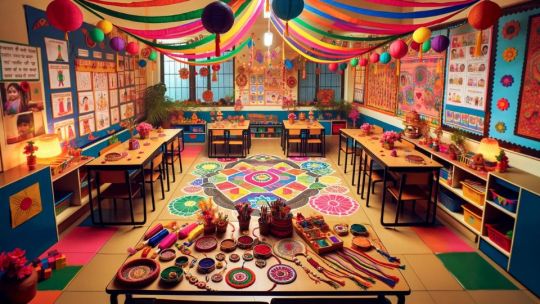
Introduction to Raksha Bandhan
Before diving into decoration ideas, it's essential to provide preschoolers with a simple and child-friendly explanation of Raksha Bandhan. You can say:
"Raksha Bandhan is a special day when brothers and sisters show their love for each other. Sisters tie colorful bands called 'rakhis' on their brothers' wrists, and brothers promise to protect and take care of their sisters. It's a day to celebrate the wonderful bond between siblings."
Creative Raksha Bandhan Decoration Ideas
Let's explore a variety of preschool classroom decoration ideas that can transform your preschool classroom into a festive and engaging space for Raksha Bandhan:
Rakhi Art and Craft Corner:
Set up a designated craft corner with colorful paper, markers, glue, and other craft supplies.
Encourage preschoolers to create their own rakhi artwork, which can include rakhi cards or decorative rakhi bands.
Display the children's creations around the classroom to add a personalized touch.
Rangoli Designs:
Create vibrant rangoli designs at the entrance of the classroom or in a central area.
Use colored rice, flower petals, or colored sand to make eye-catching rangoli patterns.
Rangoli designs can introduce children to the rich artistic traditions of India.
Rakhi Wall Display:
Dedicate a wall in the classroom as the "Rakhi Wall."
Invite children to stick colorful paper rakhis made by them on this wall.
You can also include small photos of the students with their siblings to celebrate their unique bonds.
Themed Bulletin Board:
Decorate a bulletin board with a Raksha Bandhan theme.
Include pictures of famous sibling pairs from Indian mythology, such as Lord Rama and Goddess Sita or Krishna and Balarama.
Add captions that explain the significance of these sibling relationships.
Rakhi Garland:
String together small, colorful paper rakhis to create a rakhi garland.
Hang this garland across the classroom or along the walls to infuse a festive atmosphere.
Sibling Handprint Art:
Encourage siblings or classroom buddies to create handprint art together.
Dipping their hands in paint and creating art can symbolize their unique bonds.
Storytelling Corner:
Create a cozy corner in the classroom with cushions and soft toys.
Use this area for Raksha Bandhan storytelling sessions where teachers can read stories related to the festival and sibling relationships.
Rakhi-Making Contest:
Organize a rakhi-making contest among the children.
Encourage them to come up with creative designs and use various craft materials.
Recognize and reward their efforts with small prizes or certificates.
Sibling Photo Collage:
Request parents to provide pictures of their children with their siblings.
Create a heartwarming photo collage displaying these images.
This collage can serve as a visual representation of the diverse sibling relationships within the class.
Traditional Attire Day:
Celebrate Raksha Bandhan by inviting children to dress in traditional Indian attire.
It adds a colorful and festive touch to the celebration and allows children to embrace cultural diversity.
Conclusion
Raksha Bandhan provides a unique opportunity to introduce preschoolers to Indian culture and traditions while fostering a sense of togetherness and love. Decorating the preschool classroom with these creative Raksha Bandhan ideas not only makes the festival memorable but also instills values of love, care, and the significance of sibling relationships in young minds.
As you implement these decoration ideas, involve the children in the process to encourage their creativity and engagement. Raksha Bandhan in the best preschools in India can be a heartwarming and joyous occasion for both educators and students, leaving a lasting impression and fostering a sense of cultural appreciation and familial bonds.
Originally Published by HelloParent.
0 notes
Text
The Four Holy Shrines of the Chardham Yatra

Chardham Yatra of Uttarakhand is a revered place located in the Himalayas. This journey is located in the Himalayas of Uttarakhand and on this journey, you can visit the most famous places of Uttarakhand which are Yamunotri Dham, Gangotri Dham, Kedarnath Dham, and Badrinath Dham. Chardham is formed by combining these four holy places. These four Dhams have their own importance, beliefs, and mythological stories. These four pilgrimage sites are highly revered among Hindus.
Yamunotri Dham
Yamunotri Dham is located in Uttarkashi, Uttarakhand, at an altitude of 3,235 meters. Yamunotri Dham is the place from where the Yamunotri River originates. Yamunotri Dham is the first stop among the Chardhams and this temple is dedicated to Yamuna Devi. Yamunotri Dham is situated at a distance of 255 km from Haridwar. According to ancient beliefs, Yamuna Devi is the daughter of Surya Dev. Surya Dev's two wives Sangya and Chaya had four children, Goddess Yamuna, Yam, Shanidev, and Vaishvat Manu, hence Yamuna's mother is the sister of Yamraj and Shanidev. Kalindi is also the name of Mother Yamuna. It got this name because Mother Yamuna first appeared in her water form on Mount Kalind. Saptrishi Kund is also situated on top of Kalind Mountain. A very ancient temple of Shanidev is situated here in Kharshali, which is considered very auspicious to visit. It is believed that whoever takes a bath in the water of Yamuna with a true heart and has darshan of Shani Dev situated nearby, all his sorrows are resolved, And only by visiting Surya Kund, Divya Shila, and Vishnu Kund in Yamunotri, one gets freedom from sins.
It is believed that earlier Asit Muni used to reside here.
Yamunotri Dham was built by the Queen of Jaipur. Once this temple was badly damaged by an earthquake. And it was constructed again. Yamunotri Marg Hanuman Chatti is the last motor stop on the Yamunotri pilgrimage. After this one goes through Narada Chatti, Phool Chatti, and Janaki Chatti. The walking route starts from Janaki Chatti to Yamunotri. Among all these Chattis, Janaki Chatti is more important because there are good arrangements for night rest there And hence travelers mostly stay here for rest at night. Once a woman named Janaki Devi had built a huge Dharmshala on the banks of Yamuna in Beef village in 1946. Since then Beef Village came to be known as Janaki Chatti.
Gangotri Dham
Gangotri Dham is located in the mountains of Uttarakhand and is the second stop of the Chardham Yatra. Gangotri is the origin place of the River Ganga. Gangotri Temple is situated at an altitude of 3,042 meters above sea level. Gangotri Dham is situated at a distance of 100 km from Uttarkashi. The construction of Gangotri Temple was done by the Gorkha Commander whose name was Amar Singh Thapa in the 18th century and the construction of the temple which is currently situated in Vartaman was again done by the Rajgharana of Jaipur. The doors of Gangotri Temple open on the day of Akshaya Tritya and close on the day of Diwali. According to the ancient stories, Lord Rama's ancestor Raja Bhagirathi sat on a rock and did the penance of Lord Shankar there or got the Gangotri temple built near this rock. It is also believed that the Pandavas also performed a divine yagya at this place for the spiritual peace of their relatives who were killed in the Mahabharata war. Gangotri temple is made of granite stones, these stones are white in color, hence the color of Gangotri temple is white and this white colored temple looks very beautiful. A natural rock in the form of Shivalinga is situated in the Bhagirathi River. It is believed that this is the same place where Lord Shiva had held Mother Ganga in his locks this Shivalinga can be seen only at the beginning of winter because at that time the level of river Ganga becomes very low.
Gangotri city gradually started developing around the Gangotri Temple Because earlier the pilgrimage to Chardham Temple used to be difficult due to the Walking and Durgan paths. Then in 1980, development started in Gangotri and roads were built and then Gangotri City started developing rapidly. In ancient times, when there was no temple situated here, the Ganga River was directly worshiped by the Semwal priests There was a platform near the place where the Bhagirathi rock was installed. Where idols were installed for a few months during the season time All these idols were brought here from Mukhba Village and after the end of the season, they were sent back to Mukhba Village. It is believed that after Senapati Amar Singh built this temple in the 18th century, the temple was repaired in the 20th century. Many species of flora will be seen in the Gangotri region, along with this you will also get to see many types of wild animals here such as red monkeys, brown bears, foxes, barking deer, musk deer, etc.
Kedarnath Dham
Kedarnath Temple is situated in Rudraprayag of Uttarakhand state of India. This temple is the third stop of the famous Chardham Yatra. Kedarnath Temple is situated in the Himalayas of Uttarakhand where you can see snow mountains all around this view looks very beautiful and charming while trekking. Apart from being an important part of the Char Dham Yatra, Kedarnath Dham is also a very important part of the worshiped 12 Jyotirlingas. Kedarnath Temple opens from April to November because after that the climate here becomes too harsh for humans. It is believed that this temple was built by Maharaja Janmejay, the grandson of Pandavas, and Adi Shankaracharya renovated this temple. Kedarnath Temple suffered the most damage due to the sudden flood and landslide in June 2013. Many houses and temples were washed away. But the main part of Kedarnath temple (Dome and Gate) Thank you, it is a miracle that even though everything was destroyed by Disaster, only the Kedarnath temple was not damaged. In the disaster of 2013, a big rock suddenly got stuck mysteriously right behind the temple. The fast-flowing water was divided into two parts so that which Kedarnath Temple was not damaged in any way all the people who were taking shelter in the temple did not suffer any harm and the next day all of them were rescued by the Indian Army.
A lot is said about the construction of Kedarnath Temple, from Adi Shankara Charya to Pandavas. Kedarnath Temple has existed for 1200 years. Kedarnath has a unique natural beauty, which is visible even in the 21st century, The hills here are situated at different heights, The highest of which is Kedarnath hill, which is situated at an altitude of 22,000 feet. Also, nearby this place are Karachkund and Bharatkund, which are famous for their different beauty and heights. Even after so much progress, it is still not possible to reach this place with a Vehicle. Even today, goods are transported with the help of horses, mules, and helicopters.
You can imagine how difficult it must have been to build this temple at that time and even today, centuries later, this temple is standing strong in its place. Kedarnath Temple and Badrinath Temple are considered the main temples of Chardham. It is believed that whoever visits Badrinath temple without visiting Kedarnath temple, his visit becomes futile. There is no historical evidence regarding the age of Kedarnath Temple. But Kedarnath Temple has been a pilgrimage site for more than 1000 years.
Since the time of Adi Guru Shankaracharya, the Rawal Shivling of the Jangam community from South India has been established here. And the local Jamloki Brahmin priests worshiping Lakshminarayan. The worship from the pilgrims' side is performed by the priest Pando.
Badrinath Dham
Badrinath Temple is the last and fourth stop of the Chardham Yatra located in the mountains of Uttarakhand. Badrinath Temple is dedicated to Lord Vishnu. Badrinarayan form of Lord Vishnu is worshiped in Badrinath. Badrinath Temple is situated on the banks of the Alaknanda River. You can go to Badrinath Temple by a bridge over the Alaknanda River. Badrinath Temple is an ancient and highly revered temple among Hindus. This place is named Badrinath after the name of Badrinath Temple. It is believed that this temple was built between 7th century and 9th century.
Badrinath Temple is situated in the middle of the Himalayan mountains, hence it is cold throughout the year and there is snowfall in winter. And due to extreme cold, it becomes very difficult to come here for darshan, this is why the doors of Badrinath Temple remain closed during the winter season A 1-meter-high statue of Badrinarayan ji is installed in Badrinath Temple which is a very beautiful look at. Adi Shankaracharya removed the idol from the Samiprasth Narad Kund and installed it in the 8th century. The idol situated in Badrinath is considered to be one of the self-manifested idols. The chief priest of Badrinath Temple is a Brahmin of the Nambudiris sect of Kerala state.
You can also see the mention of Badrinath temple in Vishnupuran and Skandapuran. Badrinath Temple is the only temple that is counted among the Four major Chardhams along with the smaller Chardhams. Badrinath Temple was known by different names at different times. Like in Satyayuga it was known as Muktiprada, in Tretayuga it was known as Yoga Siddha, in Dwaparyuga it was known as Manibhadra Ashram, and in Kaliyuga it is known as Badrinath.
There is a very famous story on the origin of the name Badrinath Once Muni Narad came to Ksheer Sagar for the darshan of Lord Vishnu. Where he saw that Goddess Lakshmi was pressing the feet of Lord Vishnu. When Narad Ji saw this, So he was surprised and asked Lord Vishnu about this. So, suffering from guilt, Lord Vishnu moved towards the Himalayas for penance, and when he started doing penance in the Himalayas So there started heavy snowfall, Lord Vishnu was so engrossed in penance that he did not know anything about it. Seeing such condition of Lord Vishnu, Mother Lakshmi took the form of a plum tree and took Lord Vishnu under her shade And whatever snow fell on Mother Lakshmi, similarly Mother protected Lord Vishnu from rain and sun When Lord Vishnu completed his penance after many years of severe penance, after seeing the penance of Mother Lakshmi, the Lord blessed Mother Lakshmi and said, That, you have protected me so much in the form of a plum (Badri) tree during my years, from today onwards you will be worshiped here along with me. And you have protected me so much in the form of the Badri tree, so from today onwards I will also be known as Badrinath.
#best chardham package#chardham hotels booking#chardham package#chardham tour by helicopter#chardham2023#chardham tour package#chardhamyatra#india trip#india#tour#Chardham Yatra Package#chardham yatra by helicopter#chardham tour package by helicopter#best chardham tour package#4 Dham tour package#luxury chardham yatra package
0 notes
Text
Diwali | The Festival of Lights
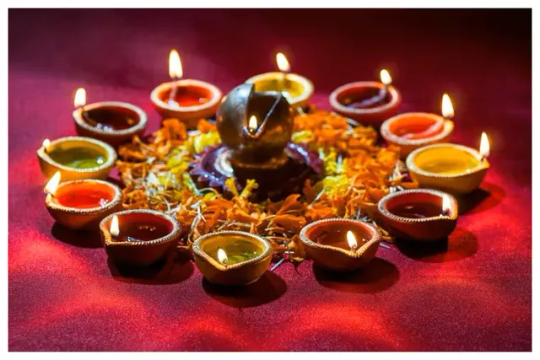
Diwali, also known as Deepawali, is a significant Hindu festival celebrated with enthusiasm every autumn. This festival of lights symbolizes the triumph of virtues over vices. Devotees on this day worship Goddess Laxmi and Lord Ganesha, followed by adorning their homes with earthen lamps and reveling in fireworks. Over time, Diwali has adapted to the modern world and has become a prominent celebration not just in India but across the globe.

Celebrating Diwali with Diyas.(Image: ucf.edu)
Origin and History
Diwali has several mythological stories associated with it, with one of the most prominent being the return of Lord Rama after his fourteen-year exile.
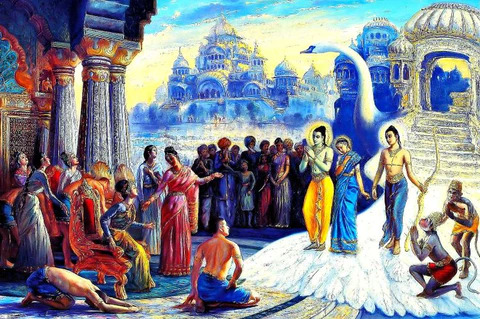
Homecoming of Rama, Lakshman and Sita( Image: thisday.app)
South India celebrates Diwali to commemorate Lord Krishna's victory over the demon king Narkasura. Legend has it that Krishna granted Narkasura's last wish to enjoy his final day with feasts, fireworks, and lights, which is still followed in the celebration of Diwali today.
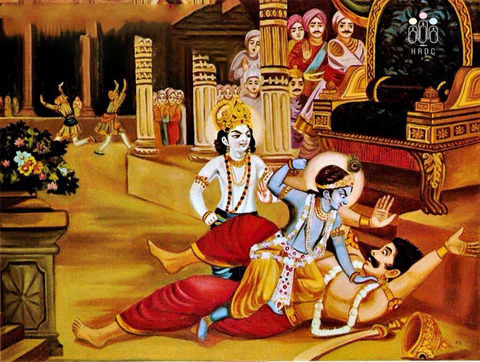
Krishna kills demon king Narkasura (Image: facebook.com)
Customs and Rituals
Diwali is a five-day festival that begins with Dhanteras and concludes with Bhai-Duj on the fifth day. Each day is marked by joyous celebrations, such as purchasing new utensils and household items on the first day, followed by house decoration with lights and rangoli on the second day. The third day, Diwali itself, holds great religious significance as people worship Goddess Lakshmi and Lord Ganesha, wear new clothes for Diwali, exchange gifts and sweets. The fourth day involves bathing deities with milk and honey and offering various delicacies. The fifth and final day, Bhai Duj, is dedicated to celebrating the eternal bond between brothers and sisters.

Different Ways of Celebrating
North India: In North India, Diwali is celebrated with fervor, including visits to puja pandals with Lakshmi-Ganesh idols and firework displays. States like Haryana and Punjab have grand firework shows in honor of Lord Ram, Sita, and Lakshman.

South India: South Indians celebrate Diwali in the morning with rituals such as morning baths, Kolam rangoli decoration, new clothes, and prayers.
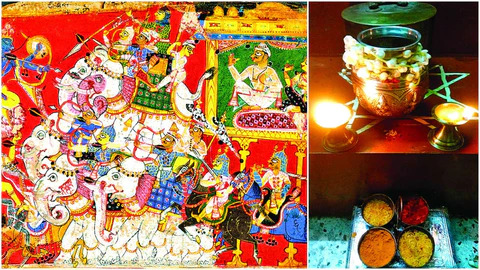
East India: In West Bengal and Eastern states, Diwali is marked by the worship of Goddess Kali and a focus on honoring ancestors. Houses are adorned with alpona and sweet rosogullas are exchanged.

West India: In Maharashtra and parts of Western India, the day of Narkachaturdashi symbolizes the victory of good over evil with fireworks. The second day involves Lakshmi and Ganesh Puja, with worship of earthen idols. The third day, Padwa, includes extensive shopping and tilak ceremonies.

Modern Diwali
Over time, Diwali celebrations have evolved and adapted to the modern world. Commercialization has played a significant role in this transformation. Diwali is no longer limited to Hindus, and it has become a global festival while preserving its core essence.
Global Celebration
What to wear for Diwali, such as Chaniya-Cholis, sees a surge in sales worldwide, as people, including NRIs and foreigners, seek unique designs. Sarees are appreciated globally for their elegance and grace.
Eco-Friendly Celebrations
To promote sustainability, people have started using eco-friendly candles and 3-D crackers. Gifting options now prioritize environmentally friendly materials over plastic, and parties aim to minimize waste by serving food on bamboo leaves instead of thermocol plates.
Varieties in Styles and Attires
For Women:
Sarees: Sarees are a favorite choice for Indian women for , with a wide variety of materials such as silk, crepe, and chiffon. These can be paired with midriff-baring blouses and elegant Jhumkis (long earrings).
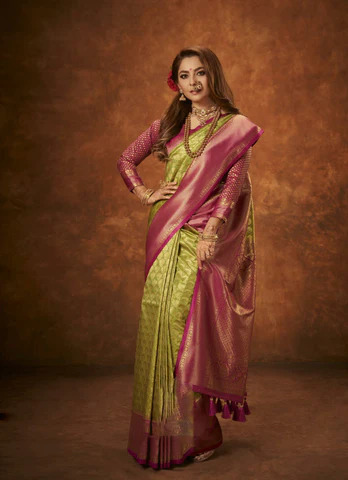
Lehenga Choli: Popular in Rajasthan and Gujarat, Lehenga Cholis are known for their bright colors and contrasting dupattas.
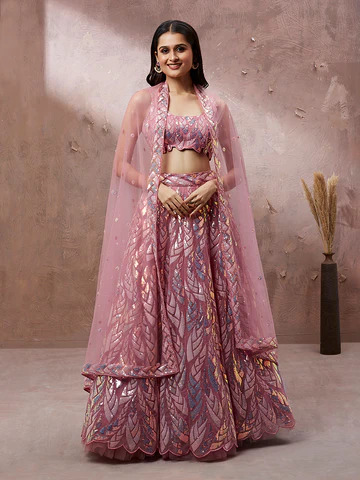
Anarkali: Anarkali suits are a comfortable and stylish option, with numerous designs available. Look Stunning in this Diwali outfit. Pair them with a studded clutch and bangles for a stunning look.

Sharara: Sharara sets for women have always been a favourite Diwali outfit. Sharara suits bring with them beauty

1 note
·
View note
Text
The Festival of Diwali: The Light Over Darkness

Diwali, also known as Deepavali, is one of the most popular and widely celebrated festivals in India. It is a Hindu festival that celebrates the victory of light over darkness, good over evil, and knowledge over ignorance. It's not just celebrated in India but also by communities around the world including Nepal, Sri Lanka, Malaysia, and among the diaspora in the United States, Canada, and the United Kingdom.
Historical Background
Hindu Mythology
The roots of Diwali are embedded in Hindu mythology. One popular story associated with Diwali is the return of Lord Rama to his kingdom of Ayodhya after defeating the demon king Ravana. The citizens of Ayodhya celebrated this triumphant return by lighting oil lamps throughout the kingdom.
Jainism and Sikhism
It's not just a Hindu festival, though. For Jains, Diwali marks the day Lord Mahavira attained Nirvana. Sikhs celebrate Diwali as the day when Guru Hargobind Ji was released from imprisonment.
Significance
Spiritual
Spiritually, Diwali symbolizes the internal struggle against darkness in the form of ignorance, greed, and hatred. The lighting of lamps signifies enlightening oneself and driving away these negative aspects.
Cultural
Culturally, it's a time for families to come together, often traveling long distances to be with loved ones. It often coincides with the Hindu New Year, and many businesses in India start their financial new year at Diwali.
Economic
Economically, Diwali is a significant period of spending, both on festivities and on big-ticket items, thus boosting the economy.
How is Diwali Celebrated?
Preparations
Cleaning: Homes are cleaned thoroughly.
Decorating: Rangoli, colorful patterns made from colored powder or rice, are drawn.
Shopping: New clothes and gifts are purchased.
Five Days of Celebration
Dhanteras: The festival starts with Dhanteras, a day set aside for buying gold and silver.
Naraka Chaturdashi: Also known as Choti Diwali, it's a day of preparing festive foods.
Diwali: The main day when Lakshmi, the goddess of wealth, is worshipped.
Govardhan Puja: Known as Annakut, it's a day of food, when mountains of sweets are offered at temples.
Bhai Dooj: A day dedicated to the bond between brothers and sisters.
Activities
Fireworks: Firework displays are common, although increasingly controversial due to environmental concerns.
Sweets: Traditional Indian sweets like 'laddoo', 'gulab jamun' and 'barfi' are prepared and shared.
Gifts: It's customary to exchange gifts, often sweets or items like utensils and clothes.
Variations
Different communities celebrate Diwali in various ways:
Bengal: The goddess Kali is worshipped.
Gujarat: The New Year is celebrated the day after Diwali.
South India: Diwali is celebrated on Naraka Chaturdashi, a day before it is celebrated in the rest of India.
Environmental and Safety Concerns
Pollution
The widespread use of fireworks has led to concerns about air pollution.
Alternatives
LED Lamps: People are increasingly using LED lamps instead of traditional oil lamps.
Eco-friendly Fireworks: Use of eco-friendly fireworks that produce less smoke and noise.
Conclusion
Diwali is a multi-faceted festival with deep cultural and spiritual significance. While it is a time of great celebration, the contemporary version of Diwali is also evolving to adapt to environmental and societal concerns.
By understanding the rich tapestry of traditions, meanings, and celebrations that make up Diwali, one can truly appreciate why it holds such a special place in the hearts of millions worldwide.
1 note
·
View note
Text
Diwali Wishes and its Importance - Lighting up Lives and Hearts
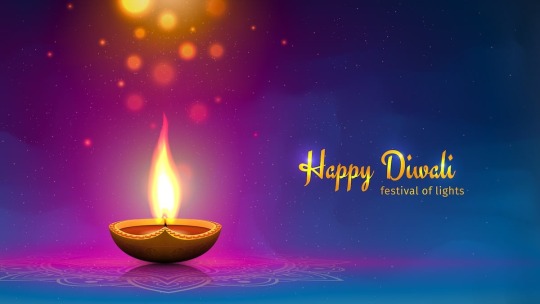
As the festive season rolls in, the brightness and positivity in the air become palpable. Among this festive jubilation, Diwali, or the 'festival of lights,' holds a special place, not just in our hearts but also in our traditions and culture. This blog aims to shed light on the significance of Diwali and emphasize the profound essence behind the simple and heartwarming tradition of sharing Diwali wishes.
Diwali – The Festival of Lights
The magnificence of Diwali is widespread, encompassing enthusiasm, joy and a sense of oneness. Renowned as a major Hindu festival, Diwali is celebrated with equal zest by different communities and religions around the world. It symbolizes the spiritual victory of light over darkness, good over evil, and knowledge over ignorance.
This vibrant festival centers around lighting oil lamps, delicious feasts, sharing sweets, decorating homes, and most importantly, extending warm and sincere Diwali wishes to our loved ones. Why is this small act of exchanging wishes so significant, you might wonder? Let's take a closer look!
The Power of Diwali Wishes
Our lives have become enmeshed in the digital world, where emails and text messages have largely replaced handwritten notes and greeting cards. Amidst this fast-paced life, Diwali offers us a wonderful opportunity to pause, reflect, and connect on a human level.
Sharing Diwali wishes is not about executing a formal protocol. Instead, it's a genuine gesture full of affection, goodwill, and hope. It's about uplifting spirits, kindling smiles, building bridges, and cherishing relationships. It's about lighting the lamp of joy in another's life while brightening our own—echoing the very ethos of Diwali.
Deep Dive into Diwali's Significance
Diwali is not just a one-day event but a confluence of various philosophies and legends, expanding over five days—each day symbolizing a unique moral value.
Dhanteras - The first day signifies wealth and prosperity. It's a day when businesses commence their financial year, and people buy new items, especially gold and silver, as a sign of good luck.
Naraka Chaturdasi - This day marks the victory of Lord Krishna over the demon Narakasura, symbolizing the triumph of good over evil.
Diwali - On this day, Lord Rama returned back to Ayodhya after fourteen years of exile, and the city was lit with rows of Diyas to celebrate his return.
Govardhan Puja - This day emphasizes the importance of nature and its preservation as Lord Krishna defeated Indra, the god of rain and thunder, teaching him about pride and revenge.
Bhai Dooj - This day is dedicated to celebrating the bond of love and care between brothers and sisters.
Conclusion
In conclusion, as we prepare to step into the bright aura of Diwali, let's not forget the true essence of this festival. While we clean every corner of our homes and illuminate them with lamps, let's also clean our hearts of malice and light them with love and compassion. As we share Diwali wishes, let's genuinely aim to uplift and light up someone's life. And as we celebrate, let's not leave anyone behind. Because Diwali, after all, is about spreading joy, sharing love, and lighting up lives!
Here's wishing everyone a very Happy Diwali! May this festival of lights fill your life with moments of joy, peace, and happiness.
"Deepavali ka yeh pyara tyohaar,
Jeevan mein laye aapke khushiya apaar,
Lakshmiji viraaje aapke dwar,
Shubhkamna hamari kare sweekar!
Diwali Ki Bahut Bahut Badhai!"
[May this lovely festival of Diwali,
bring immeasurable joy in your life,
May Goddess Lakshmi grace your home,
Accept our heartfelt wishes of Diwali!
Many Many Congratulations on Diwali!]
Happy Diwali!
0 notes
Text
Karunanidhi

This Biography is about one of the best Indian Politician Karunanidhi including his Height, weight, Age & Other Detail…
Express info
Real Name
Muthuvel Karunanidhi (born Daksinamoorthy)
Nickname
Kalaignar
Profession
Indian Politician
Date of death
7 August 2018
Physical Stats & More Info
Party
Dravida Munnetra Kazhagam (DMK)
Political Journey
• Karunanidhi entered politics at just 14 and participated in Anti-Hindu agitations and then founded an organization for the local youth. He then circulated Manavar Nesan, a handwritten newspaper to its members.
• He later found Tamil Nadu Tamil Manavar Mandram, the first student wing of Dravidan Movement.
• In 1957, he was elected to the Tamil Nadu assembly for the first time from the Kulithalai constituency of Thiruchirapalli district representing DMK.
• He became party treasurer in 1961.
• Karunanidhi was made the minister for public works in 1967 when DMK was elected to the power in the state.
• Annadurai's death in 1969 earned him the post of party leader and became the Chief Minister of Tamil Nadu. He has since then maintained his post.
Biggest Rival
Jayalalithaa Jayaram
Physical Stats & More of Karunanidhi
Height (approx.)
in centimeters- 168 cm
in meters- 1.68 m
in Feet Inches- 5’ 6”
Weight (approx.)
in Kilograms- 87 kg
in Pounds- 192 lbs
Eye Colour
Black
Hair Colour
Semi-Bald (White)
Personal Life of Karunanidhi
Date of Birth
3 June 1924
Age (as in 2018)
94 Years
Birth Place
Thirukuvalai, Tanjore district, Madras Presidency, British India
Zodiac sign/Sun sign
Gemini
Nationality
Indian
Hometown
Madras, Tamil Nadu India
School
Not Known
Debut
Tamil Film Industry- Rajakumari was the first film for which he wrote the script back in 1947 which gained him popularity he needed to continue in the field.
Politics- He was inspired by the speech of Alagiriswamii of the Justice Party and jumped to the politics at just 14 and participated in Anti-Hindu agitations.
Family
Father- Muthuvelar Karunanidhi
Mother- Anjugam Karunanidhi
Brother- Not Known
Sister- Not Known
Religion
Atheism
Controversies
• Sarkaria Commission accused Karunanidhi of his involvement in corruption in the allotment of tenders for Veeranam project, for which his government was dismissed by the then Prime Minister Indira Gandhi.
• In 2001, Karunanidhi along with former Chief Secretary K.A. Nambiar was arrested based on charges of corruption in the construction of flyovers in Chennai. He and his party members were charged under several sections of the IPC. However, no rigid evidence was found against them.
• In 2012, while celebrating the party founding day, Karunanidhi and party workers were received by a group of people who were dressed portraying some of the Hindu gods.
• He once made a controversial remark against Sethusamudram controversy, questioning the existence of God and asking about the college from where Lord Rama graduated in Engineering for building the Ramar Sethu bridge.
• He had been accused of having links with Liberation Tigers of Tamil Eelam (LTTE), a militant group to create an independent state of Tamil Eelam in the north and east of Sri Lanka for Tamil people and encouraging them to assassinate Rajiv Gandhi. However, the final report had no such allegations on him.
• Some political observers, his party members, and opponents accused him of promoting nepotism (favouring the relatives), for helping his son M. K. Stalin to rise in the party.
Girls, Affairs and More of Karunanidhi
Marital Status
Married
Affairs/Girlfriends
N/A
Wife
Late Padmavathy
Dayalu Ammal
Rajathi Ammal
Children
Son- M. K. Muthu (Indian Actor, Singer, and Politician)
M. K. Alagiri (Indian Politician)
M. K. Stalin (Indian Politician)
M. K. Tamilarasu (Film Producer)
Daughter- Selvi
Kanimozhi (Rajya Sabha MP)
Money Factor of Karunanidhi
Salary
Not Known
Net Worth (approx.)
INR 11,94,37,427 (as of 2016)
This Biography written By www.welidot.com
Read the full article
0 notes
Text
The macho hero Gopichand is all set to have a huge comeback in Telugu with his upcoming venture with the director Sriwass. Touted to be their third project in the combination, the makers have released the first look poster on the happy occasion of Sri Rama Navami.
The poster presents the fresh look of manly hero Gopichand alongside his co-star Jagapathy Babu holding hand in hand walking happily giving us the vibes of brothers Lord Rama and Lakshmana. Since the poster was released on the eve of the festival, one can anticipate that this movie is a complete family entertainer which is filled with brotherhood emotions. Gopichand and Jagapathy Babu worked together in the movie Lakshyam as brothers and the movie ended up as a hit as they shared beautiful camaraderie between them. After all these years, they are again seen as brothers under the director Sriwass. Sriwas and Gopichand delivered two back-to-back hits with the movies ‘Lakshyam’ and ‘Loukyam’. Now this movie ‘Ramabanam’ would surely give them a hat trick success.
Mickey J Meyer is handling the music department scoring for the first time for Gopichand and Kushbu Sundar is portraying the sister-in-law role for the hero opposite Jagapathy Babu. People’s Media Factory the production banner of this movie is releasing it on the 5th of May, this Summer.
0 notes
Text
#8 WEEKLY J0URNAL
Deepavali is one of my favourite festivals. It is one of India's most widely celebrated festivals, and it is a time when people come together to celebrate the triumph of light over darkness.
The festival is usually celebrated over a period of five days, and each day has its own significance. The first day is known as Dhanteras, which is dedicated to the worship of the goddess of wealth, Goddess Lakshmi. The second day is known as Naraka Chaturdashi, which marks the day when Lord Krishna defeated the demon Narakasura. The third day is the main day of the festival, which is when people celebrate the victory of Lord Rama over the demon king Ravana. The fourth day is known as Govardhan Puja, which is dedicated to the worship of Lord Krishna. And the fifth and final day is known as Bhai Dooj, which is a day for brothers and sisters to celebrate their bond.
What I love most about Deepavali is the feeling of togetherness and joy that it brings. People decorate their homes with lights and rangolis, and the entire atmosphere is filled with excitement and positivity. The sound of firecrackers fills the air, and the aroma of delicious food being cooked wafts through the streets.
One of the most important traditions of Deepavali is the exchange of sweets and gifts among friends and family. People dress up in new clothes, visit each other's homes, and exchange greetings and gifts. It is a time to strengthen relationships and celebrate the bonds of love and friendship.
Another thing I love about Deepavali is the food. It is a time when people prepare traditional sweets and delicacies like gulab jamun, laddoos, and barfi. The aroma of these sweets being prepared fills the air, and it is a time when people indulge in delicious treats without any guilt.
In conclusion, Deepavali is a festival that I look forward to every year. It is a time when people come together to celebrate the victory of good over evil, and it is a time for joy, togetherness, and celebration. Whether it is the exchange of gifts, the delicious food, or the colorful decorations, every aspect of this festival fills me with happiness and positivity.
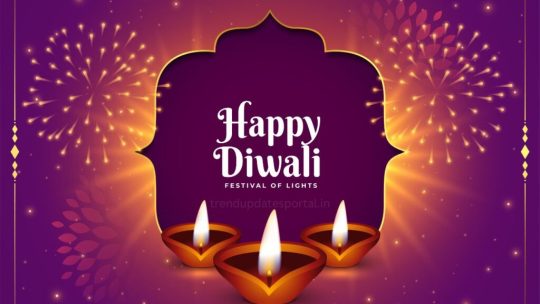
0 notes
Text
Nav Varsh Abhinandan
The beautiful Spring season is here and the Chaitra Navratri shall follow soon. The new leaves, buds and flowers signify new life, new beginnings, prosperity and renewed hope! Our ancients calculated the new year from the auspicious Chaitra month. On 22 March, 1957, the Gregorian calendar was adopted for official purposes. 22 March, 2023 of the Gregorian calendar marks the beginning of the Vikrami Samvat 2080.
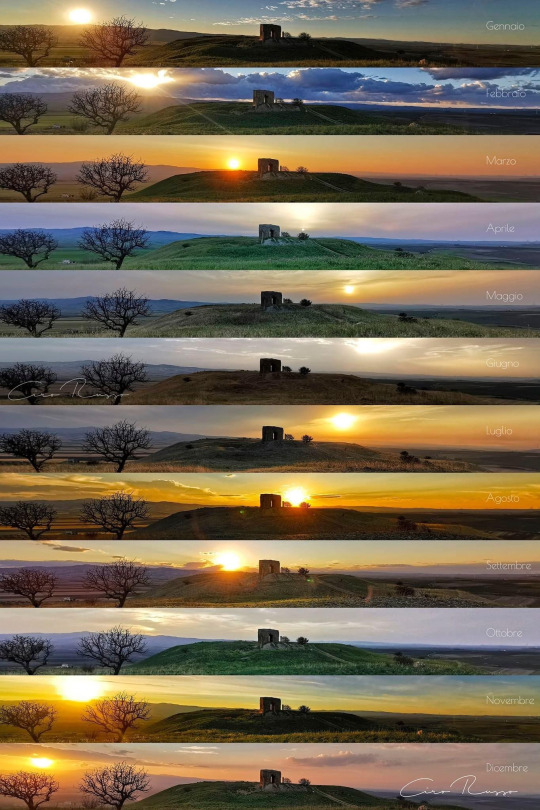
(The image above shows 12 Pictures of The Sun, Each Month, Same Place, Same Time. Photo by Ciro Russo)
Lord Brahma started creating the universe on the first day of the Chaitra Navratri. Jau (barley) was the first crop to be cultivated then. We sow Jau and grow Khetri in reverence of this crop and then offer it back to Mother Nature. King Vikramaditya was coronated King on this day. The Vikrami Samvat or the Hindu calendar is named after him.
Navratri literally means nine nights. These nights are symbolic of the darkness of ignorance. The purpose of celebrating Navratri is to enable humans to overcome this darkness. When we worship the Devi or the Mother Goddess, she is the unified form of Durga, Lakshmi and Saraswati. These three forms together form Shakti (power). This Shakti is the energy that is emanant in Nature and the Lord himself controls it. The ninth day of the Chaitra Navratri is Ram Navami. This marks the birthday and the coronation of Bhagwan Rama.
The feminine aspect of Divinity is worshipped in Navratri. Sri Sathya Sai Baba says that the word Stree is made up of- Sa, Ta and Ra. Sa signifies Sattvic, Ta signifies Tamasic and Ra signifies the Rajasic nature of women. Stree thus represents the combination of the three gunas. You can judge a house by the Greh-Lakhmi (lady of the house), she represents the ‘everything’ of the house.
The Vedas declare that where women are honoured, there divinity is present with all its potency. We worship five kinds of mothers. Firstly, we worship the Deha-Mata. She is the one who bore us for nine months and gave us the gift of life. Secondly, we worship the Gau-Mata. The cow is given the exalted position of a mother because she sustains us by converting her blood into milk. Thirdly, we revere the Bhu-Mata or Mother Earth. She is the one, on whom we are dependant for everything like shelter, water, food etc. Fourthly, we revere the Desh-Mata. Our country gives us protection, rights and the support system of society. Indians are perhaps the only people who revere the country as Mother India. Fifthly, we revere the Veda-Mata. We revere the Vedas as our heritage and as spiritual treasures. They tell us the purpose of life and guide us on the path of self-realisation.
For those who are not spiritually inclined, I would say that Navaratri is a time to revere nature and offer thanksgiving for all that nature has bestowed us with. Resources like the Earth, air, water, minerals, oils etc. should not be wasted or misused. It is important to conserve the environment for the generations to come.
Scientifically speaking, the Chaitra Navratri is placed at the intersection of winter and summer. The body needs to detox at this time to adjust itself for the upcoming summer season. And that is exactly why Navratri fasting is recommended. You can have fruits and nuts along with one meal of alternate grains (no cereals like wheat, rice etc.). Navratri foods include Kuttu ka atta, Swaank ke chawal, Singhaare ka aata, etc. And you cook with Rock salt which is an excellent detoxifying agent. But remember that a fast is a fast, as long as you don’t convert it into a feast!
So let’s do Devi Pooja in Navratri and revere the Mother Goddess in her beautiful Nav-Durga form. And while doing Devi-Poojan and Kanya-Poojan, do extend the respect to all the living goddesses around you … your mother, wife, sister, daughter, daughter-in-law and just any girl out there! Happy Navratri!
(This piece has been published in the HT on 19.03.2023)
#vikramsamvat#vikramisamvat#navratri#chaitra navratri 2023#kanyapoojan#SathyaSaiBaba#Sathya Sai#SriSathyaSaiVidyaVahini
0 notes
Text
Uttarakhand - Land Of Gods
Uttarakhand is the home to many spiritual sites like the Chota Char Dham which includes places like Kedarnath, Badrinath, Yamunotri, and Gangotri. There are almost 142 temples in the region which are visited by millions of people all around the world. Adi Badri, Augustmuni, Badrinath, and Baleshwar are some of the most famous temples. The highest Shiva temple Tungnath which is more than 1000 years old is exceptional and also exists in Uttarakhand. Panch Kedar comprises 5 places where different parts of Lord Shiva appeared when he disguised himself as Nandi the bull and was trying to hide from Pandavas and Draupadi.
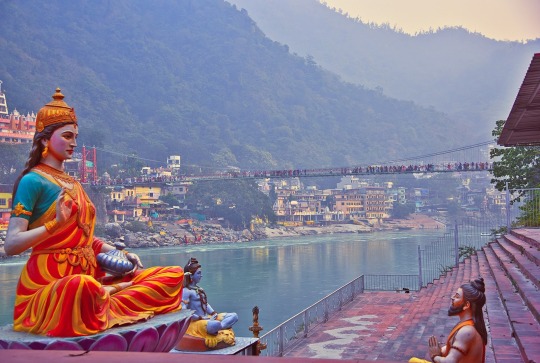
Mythology around Uttarakhand
Uttarakhand has many legendary tales woven into it, like the story of Pandavas ascending to heaven. To attain Moksha Pandavas came to Lord Shiva. He was not willing to forgive him because Pandavas has committed the heinous crime of killing their own brother Kauravas. Lord Shiva disguised himself as a bull called Nandi and hid among other bulls in Guptkashi. Later Pandavas found him but were only able to catch the hemp of the bull. The place where the hemp appeared is where the temple Kedarnath is built. Other places where the other parts of Nandi appeared were called Panch Kedar. Later Lord Shiva forgave Pandavs and they ascended into heaven. Another story revolves around Raja Daksha whose daughter Sati was married to Lord Shiva. Once Raja Daksha arranged a Yagya to which Lord Shiva was not invited which caused grief in the heart of Sati. She came to the Yagya and left her body which made Lord shiva severe the head of her father Daksha in anger. Later Mahadev gave a second life to King Daksh by placing a goat’s head and said that now the place will be known after his name. Hence the temple called “Daksheshwar Mahadev Temple” was named after King Daksha Prajapati and it is situated in Haridwar. Guru Dronacharya is one of the most renowned teachers of all time. According to legends he had meditated in a cave near Dehradun Uttarakhand. Later that cave was made into a temple called Tapkeshwar. Tales from Ramayana mention that Lord Rama meditated in the world’s highest temple devoted to Shiva called Tungnath. There are lots of tales about Lord Shiva in Uttarakhand, one among them being the marriage between Lord Shiva and Parvati. It happened in Triguginarayan temple which is said to be situated in the Rudraprayag district of Uttarakhand. It is said that the fire which witnessed the wedding still exists inside the temple and it is said it will never cease and will exist for eternity.
Chota Char Dham
There are four pilgrim sites which are jointly termed as Chota Char Dham.

Kedarnath - the pilgrim site which has both historical and religious significance. It is said Pandavas built this temple when Bheema tried to catch the bull but only was able to catch the hemp of Nandi. Lord Shiva disguised himself as a bull because he could not forgive Pandavas for their crimes at the war of Kurukshetra. Pandavas had to kill Kaurvas who were brothers to them. Later Pandavas attained salvation and ascended to heaven. The temple is one among the 12 Jyotirlingas and is devoted to Lord Shiva who is one among the Trimurti.
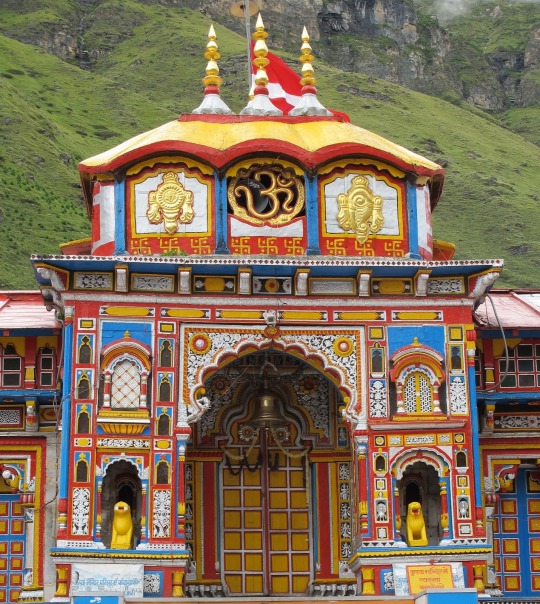
Badrinath - the temple is devoted to Lord Shiva and is situated near the bank of the river Alaknanda. The religious site is part of both Chota Char Dham and Char Dham. The place is said to be reestablished by the monk Adi Shankara. Badrikashram which is now called Badrinath temple is a place where Lord Vishnu in the form of Nara and Narayana underwent severe repentance. You can see the Neelkanth Parbat from Badrinath temple. The temple remains closed for six months due to the extreme snowfall that happens in the region.

Yamunotri - the shrine dedicated to Goddess Yamuna and the region is said to be the place where the River Yamuna originated. It is also a seat of the Goddess who according to Hindu Mythology is the sister of God Yama who is known as the God Of Death. The place is known for its glaciers and thermal springs. The place is the first of the Chota Char Dham and is the toughest place to trek. Due to the compact and narrow nature of the paths, the place is the toughest place to go for trekking.
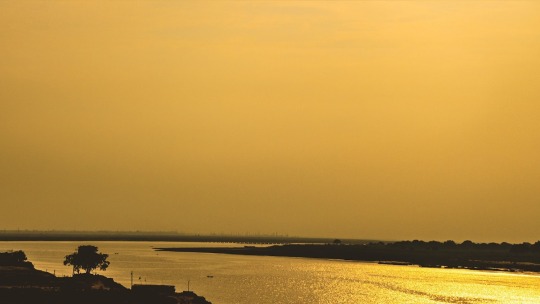
Gangotri - one among the Chota Char Dham which is said to be the seat of Goddess Ganga. It is the place where the river Ganga originated. The place opens on the day of Akshaya Tritiya and closes on the day of Bhai Dooj according to sources. Legend says that the temple is located near a stone that was said to be worshipped by King Bhagiratha who was an avid worshipper of Lord Shiva. Everyone who has a keen interest in spirituality should visit these pilgrim sites to receive blessings from deities.
1 note
·
View note